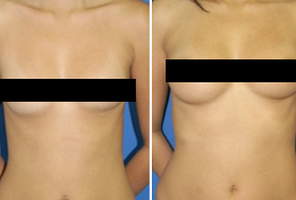More Information on Breast Augmentation
Breast augmentation, also known as breast implant surgery is the process of inserting implants behind the breasts to help women attain the desired shape and size of their breasts. For both personal cosmetic reasons and for reconstructive purposes, the American Society for Aesthetic Plastic Surgery (ASAPS) reports that over 300,000 women in the United States opted for breast augmentation procedures in 2005.
Saline breast implants are the most safe and reliable implants being used today, and are used in virtually all breast augmentation procedures. Silicone implants are used more in cases of breast reconstruction, especially in post-cancer breast reconstruction surgery. Depending on the anatomy of your breasts, the amount, type and intensity of exercise you do, your surgeon should help you choose the placement and implant most ideal for your lifestyle and comfort.
A new addition to the breast implant and augmentation market is the saline-filled adjustable breast implant. Like saline implants, these changeable implants are connected to a tube through which a surgeon can adjust the size through injection or removal of saline solution, and is used mainly to adjust breast size once after the initial surgery. The adjustable implant requires an additional incision and procedure for tube removal, and leaves an extra scar. This is not a common procedure yet, but its popularity in augmentation and implant surgery is growing.
Sizes and shapes of implants can vary. Shapes can be round or teardrop, depending on your choice and your doctor’s recommendation for your particular anatomy and body shape. In addition to choosing the size and shape of your implant - often referred to as the “profile,†you may have the option of choosing a textured or smooth implant.
Breast Implant Procedure
The augmentation and implant process begins by making a small incision either under the breast crease, in the darker area of the areola, or less frequently, in the armpit. The addition of the implant includes lifting the breast tissue and creating a pocket for insertion of the implant. The implant itself, a soft envelope of saline or silicone, is then inserted behind the breast to create size, volume and shape. This process can take up to three to four hours, and varies by the type of procedure your doctor has chosen.
Cost Breast Implants
The cost for breast implants can vary depending on the specific technique, case difficulty, your doctor and the location of the surgery. Expect the fee to range from $5000 to $6000 for all pre- and post-operative procedures. The cost of plastic surgery procedures can vary from place, by surgeon and by implant size. Be sure you find out the all-inclusive cost when you ask about the fee to avoid any hidden costs.
Recovery From Breast Implant Surgery
You will be able to return home to recover several hours after your surgery. Be aware that you will need assistance to get home and for the next 48 hours as you recover. To make your at-home recovery easier, plan your recovery ahead of time. Since breast augmentation stretches delicate tissue, it can be significantly painful, especially if implants are placed under the chest muscle. Post-surgery, most patients report feeling sore, bruised and stiff, with limited movement. Typically, the pain improves as quickly as 48 hours after the operation and can be managed by medication. Be sure to take the anti-inflammatory and antibiotic medications your doctor prescribes.
Breast Augmentation Risk
Breast augmentation is an invasive procedure and should be considered a risk equal to any other surgical procedure. Infection, bleeding, blood clotting, and scarring can all be potential risks. In addition to these risks, changes in nipple and skin sensitivity, as well as shifting of the implant within the chest can be side effects.
The main non-health related risk involved with surgical breast implants is the squeezing of the implant by scar tissue. Called capsular contracture, this concerns the tightening of the scar around the implant and can cause implants to feel hard. Treatment for hardened implants can include removing the scar surgically or replacing or removing the implant entirely. Your plastic surgeon should be able to educate you about all of the risks involved in breast enhancement during your consultation.

